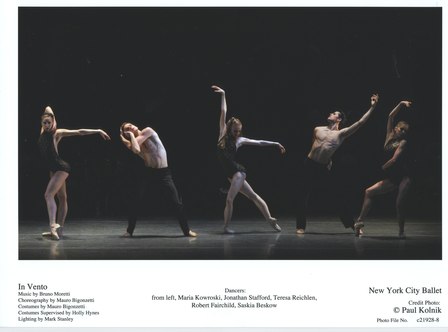|
 |
|
|
 |
 |
Because of illness and injury, Jerome Robbins's "In the Night" was replaced by "Mother Goose (Fairy Tales for Dancers)," also by Robbins, as the opening ballet. The ballet is set to Maurice Ravel's "Ma Mere L'Oye Suite," appropriately. It premiered in 1975 and has a peculiarly 70s hark-back, nostalgic setting that doesn't resonate quite the same way in 2006. A grandmother-figure, not a dancer, sits in an immensely oversize country ladder back chair, silently mouthing words, as if reading aloud from a book of fairy tales to a stage full of dancers in drab practice clothes. Two of the dancers are very young boys, the remainder are adults from the company. When the reader leaves the stage, fairy-tale dreams, of course, take over. The first tale enacted is of Sleeping Beauty (the Princess Florine is danced by Tiler Peck). This is a familiar tale and anchors the rest of the ballet. While she sleeps, the good fairy (Gwyneth Muller) brings her fragments of other fairy tales: Beauty and the Beast (more or less familiar to this audience), Hop o' My Thumb (wherein a poor woodsman intentionally loses his seven little sons in the wilderness in spite of the crumb-leaving of the youngest‰¥Ãthe crumbs are eaten by crows), and Laideronnette, Empress of the Pagodas (beautiful people demon-cursed into ugliness and serpenthood, respectively, who bathe in magical water and become beautiful again ). Each of the dreams is preceded by one of the boys bringing to the stage a box. The titles are writ large on banners that the dancers pull out of the box and parade across the stage. But because the tales are unfamiliar and the plots only sketchily rendered, they're merely puzzling. The drabness of the ballet 䴋 princesses and fairies in sparkling white notwithstanding 䴋 is overwhelming. The woman, the costumed non-dancing figure on stage along with dancers in drab costume, is perhaps a precursor of Martins's vision for Songs of the Auverne. "In Vento" is from the second of Diamond Project's choreographers, Mauro Bigonzetti. (Eliot Feld's work was presented first.) In Vento 䴋 roughly 䴝in the wind' 䴋 is choreographed to the music of Bruno Moretti, commissioned for NYCB. The soloist is Edward Liang whose performance is attention-grabbing and strong. He sits, at the beginning of the ballet (the move is repeated later in the dance), with his arms extended to the front, legs raised off the stage, knees bent, and he turns slowly to the left, then to the right without moving an obvious muscle, as if he were on a turntable. Much faster work is demanded of him as well 䴋 the wind, after all 䴋 through the ballet. His manner and delivery are sure and certain 䴋 work both focused and skillful, in the style, really, we have come to expect from Damian Woetzel. Maria Kowroski and Jason Fowler pas de deux and, when joined by Liang, pas de trois, are powerful. The stage is plain, with spot lighting and strong side-lighting. Costumes are black and the women's leotards are diaper-patterned and darkly sheer. The additional dancers 䴋 four couples 䴋 seem to crowd the stage however. With the soloist or principal roles so emphatically lit, the very strong side-lighting makes of the others a rather clumpy background, no matter how elegant their lifts and arabesques‰¥Ãall starkness and shadows. Much of the choreography is puzzling 䴋 flexed limbs and collapsed lifts, a chain of hand-holding dancers pursuing an intentionally ungraceful and very slow course across the stage spoke nothing of the wind. Mr. Liang's performance, however, is spectacular. The evening closed with an elegantly danced "Symphony in C," (George Balanchine choreography, Georges Bizet composer). The corps was right on. Duets were precise and generous. Jennie Somogyi and Jonathan Stafford danced the first movement; Sara Mearns and Stephen Hanna danced the second movement; Sterling Hyltin and Antonio Carmena danced the third movement; and, Abi Stafford and Arch Higgins danced the fourth movement. AN ADDITIONAL NOTE: There is an additional attraction 䴋 think of it as a gift, as I did 䴋 here at the New York State Theater, an exhibit of photographs that is hung in two locations in the theater. One series is hung along the west wall of the mezzanine lobby, and a second is on the orchestra level between the two coat-checks; be sure to visit both. These are exquisite, folio-size, close-up color photographs by Carin Ingalsbe of New York City Ballet costumes from the archive. Some are from ballets that have been retired. They are from different ballets, different periods in this history of the Ballet. All of them are by Karinska. The detail is remarkable and shows what goes into making these things work 䴋 most of the audience has no idea that costumes demand the great skill that is obvious here: the couture structure and the hand-set rhinestones and custom dyeing and handwork and embroidery! We see them from such a distance that we may not be aware of the detail. But, mark this well: even from the distance, all these fine elements are part and parcel of the effect, the richness of the well-staged ballet. This is a recently installed exhibit and these beautiful photographs are for sale. A portion of all sales will go toward restoration and conservation of costumes in the New York City Ballet Archive. By all means take the time to view this beautiful and informative small exhibition. Ms. Ingalsbe's work is beautiful, and the Karinska costumes are elegant. For more information, go to www.cariningalsbe.com.
 Maria Kowroski, Jonathan Stafford, Teresa Reichlen, Robert Fairchild and Saskia Beskow in New York City Ballet's In Vento Photo © & courtesy of Paul Kolnik |
|
 Tiler Peck as Princess Florine, Seth Orza as Prince Charming and Company in New York City Ballet's Mother Goose Photo © & courtesy of Paul Kolnik |
|
|
|



